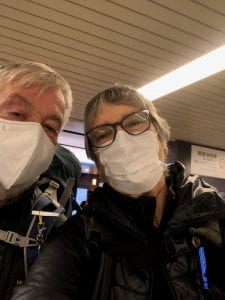Dr. Barratt's first stop on her trip is Japan! She and her husband, Will, have been enjoying their time in the country and are staying safe and healthy. Please enjoy this first installment of her travel log and check back for updates!
Highlights in Tokyo included a chance to make Japanese washi (paper) from mulberry bark and eating dango roasted over coals. Highlights in Kyoto so far have included visiting shrines and temples to enjoy plum blossoms and eating yaki-soba, udon, soba, okonomiyaki, sushi, tempura, oden, onigiri, and bentos. Blogs of the grandchildren have made wonderful conversation pieces with our Japanese hosts.
We are staying at a small temple guest house in an 8-tatami mat room with access to a common kitchen/dining room. From here we can walk to 3 UNESCO World Heritage shrines/temples, 3 grocery stores, many minor shrines and temples, a train, and more than 30 restaurants. In the evening, on the way to the laundromat, we happened to walk by the ringing of the huge temple bell, followed by drumming…magical place.
How do you pack for 7 months, summer and winter, city and rural, working and hiking? We each need to be able to manage the train with our own gear, and fit easily into a taxi. I weighed and sorted, and weighed and sorted again. But perhaps I tossed that thinking aside today as I purchased 4 new pieces of clothing from an earnest young designer at the monthly fair and sale at Kitano Tenmangu Temple.
We originally planned to travel from Japan to Korea (by boat), then to China (by boat), then by train to Ulaanbaatar. But coronavirus has us wearing masks on the train and trying to re-route through Russia: Vladivostok (by boat), Irkutsk (by train), and by train to Ulaanbaatar. This also seems blocked now – the boat is not running; we cannot get a Russian visa, and Mongolia is not accepting people from Japan. Time will tell. We plan spend summer in Mongolia (if we can get there) – too hot in DC anyway – and perhaps go home by way of the Trans-Siberian Railway to Europe.
My first trip to Japan was in 1987, and I have had three opportunities to live here. What has changed? There is more English now – trail signs, train maps, taxi drivers, and vendors. They are trying to get ready for the Olympics. Fathers are more involved in the lives of their small children. And all the mama-chari are electric. A Mama-chari (short for Mama-chariot) is a family bicycle that mothers use to transport their two children.
My first haiku since arriving:
“Japanese white eye”
A “shiroime”
Perched among the plum blossoms—
Camellias fade
“Maple”
The day’s rain-soaked moss
Holds faded “momiji” leaves
And white plum petals





